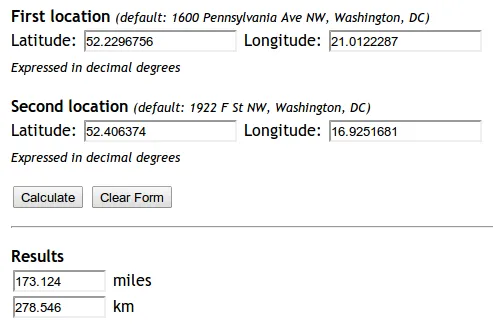根据坐标(即纬度和经度)有多种方法可以计算距离。
安装和导入
from geopy import distance
from math import sin, cos, sqrt, atan2, radians
from sklearn.neighbors import DistanceMetric
import osrm
import numpy as np
定义坐标
lat1, lon1, lat2, lon2, R = 20.9467,72.9520, 21.1702, 72.8311, 6373.0
coordinates_from = [lat1, lon1]
coordinates_to = [lat2, lon2]
使用haversine
dlon = radians(lon2) - radians(lon1)
dlat = radians(lat2) - radians(lat1)
a = sin(dlat / 2)**2 + cos(radians(lat1)) * cos(radians(lat2)) * sin(dlon / 2)**2
c = 2 * atan2(sqrt(a), sqrt(1 - a))
distance_haversine_formula = R * c
print('distance using haversine formula: ', distance_haversine_formula)
使用haversine与sklearn
dist = DistanceMetric.get_metric('haversine')
X = [[radians(lat1), radians(lon1)], [radians(lat2), radians(lon2)]]
distance_sklearn = R * dist.pairwise(X)
print('distance using sklearn: ', np.array(distance_sklearn).item(1))
使用OSRM
osrm_client = osrm.Client(host='http://router.project-osrm.org')
coordinates_osrm = [[lon1, lat1], [lon2, lat2]]
osrm_response = osrm_client.route(coordinates=coordinates_osrm, overview=osrm.overview.full)
dist_osrm = osrm_response.get('routes')[0].get('distance')/1000
print('distance using OSRM: ', dist_osrm)
使用geopy
distance_geopy = distance.distance(coordinates_from, coordinates_to).km
print('distance using geopy: ', distance_geopy)
distance_geopy_great_circle = distance.great_circle(coordinates_from, coordinates_to).km
print('distance using geopy great circle: ', distance_geopy_great_circle)
输出
distance using haversine formula: 26.07547017310917
distance using sklearn: 27.847882224769783
distance using OSRM: 33.091699999999996
distance using geopy: 27.7528030550408
distance using geopy great circle: 27.839182219511834
